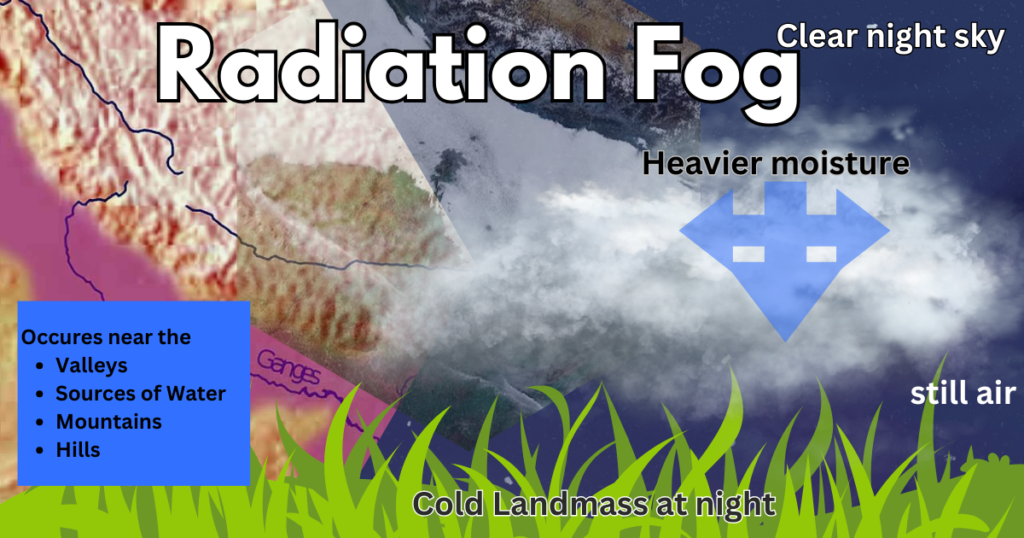The vast and fertile plain of the Ganges, spreading through India and Bangladesh, experiences a phenomenon that significantly impacts daily life and transportation during the winter months. As seen through NASA’s Terra satellite imagery on January 15, 2024, a dense blanket of fog blanketed the region, affecting major cities like Delhi, Agra, Meerut and Rohtak. This atmospheric phenomenon is known as radiation fog, a meteorological phenomenon that occurs when specific conditions meet, creating a supernatural but dangerous phenomenon.
What is radiation fog?
Radiation fog, also known as fog, emerges when the ground temperature drops significantly during the night, causing the air above to cool. Additionally, a sufficient amount of moisture remains in the air, resulting in fog formation. This type of fog is usually seen in hilly areas, valleys and near water sources. The Gangetic plain, due to its flat topography and abundance of moisture, is particularly susceptible to the formation of radiation fog during the winter months.

Impact on transport and daily life:
The presence of radiation fog in the Gangetic plains has far-reaching consequences, especially in terms of transportation. Cities along the Ganges River, often referred to as “heat islands”, contribute to creating holes in the fog blanket, causing it to lighten somewhat. However, dense fog has blanketed many areas, creating hazardous conditions for drivers, pilots and passengers.
In recent months, many flights and trains in India have been cancelled or delayed due to the prevalence of dense fog. The disruption in transportation results in widespread impact across the country, affecting the daily lives of millions of people. Scientific studies indicate that foggy weather contributes significantly to accidents, making travel during this period extremely dangerous.
Credit: PAK से कश्मीर तक… Delhi से बांग्लादेश तक फैला है Radiation Fog, NASA के सैटेलाइट ने ली तस्वीर, बताई कोहरे की वजह- Aajtak
Accidents and increasing incidents of fog:
The increase in the incidence of radiation fog in the Ganga plains has led to an increase in accidents, especially on the roads in the region. According to recent data, fog-related accidents are on the rise in India, posing a serious threat to public safety. In 2022, 14,000 people lost their lives in fog-related road accidents, while more than 15,000 suffered serious injuries.
The NASA study reveals a disturbing trend of increasing fog incidents in the Gangetic plains over the past few decades, with radiation fog being a major contributor. The reason for the increase in fog incidents is aerosol pollution, which is a result of various human activities such as emissions from vehicles, industrial emissions and burning of crop residues.
Understanding the role of aerosol pollution:
Aerosol pollution, which is characterized by the presence of fine liquid particles suspended in the air, plays an important role in the intensity of radiation fog. These aerosols act as nuclei around which water droplets can condense, forming smaller water droplets that contribute to fog thickening. Elevated levels of aerosol pollution in the Gangetic Plain are mainly induced by vehicle emissions, industrial activities and agricultural practices.
Addressing the issue:
To reduce the impact of radiation fog on the Ganga Plain, it is necessary to address the underlying causes, especially aerosol pollution. Enforcing stringent emission control measures for vehicles, regulating industrial emissions, and promoting sustainable agricultural practices can help reduce the concentration of aerosols in the air.
Additionally, investment in advanced meteorological technologies can enhance fog prediction and monitoring, allowing better preparedness for transportation disruptions and potential accidents. Better visibility aids in the timely implementation of safety measures, thereby reducing risks to passengers and passengers during fog conditions.
The prevalence of radiation fog in the Ganga plains is a complex interplay of natural meteorological conditions and human-induced factors. As the frequency of fog-related accidents increases, it becomes important to understand the dynamics of radiation fog to formulate effective mitigation strategies. By addressing the root causes, especially aerosol pollution, and adopting advanced technologies, we can try to ensure safe transportation and daily life in the fog-prone areas of the Gangetic plains.
